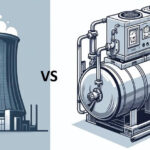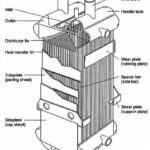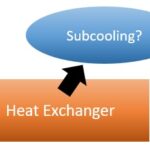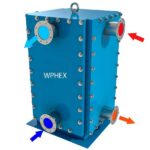Air cooled heat exchangers are a devices for rejecting heat from a fluid directly to ambient air. Unlike Shell and tube heat exchangers where rejecting heat can be to another fluid e.g. water and then to air. This type of heat exchangers doesn’t require a cooling fluid to perform the cooling instead they rely on air to cool fluids.
An Air cooled heat exchanger may be as small as an automobile radiator or large enough to reject the heat of turbine exhaust steam condensation from a 1,200 MW power plant.
In an Air cooled heat exchanger, the hot process fluid flows through a bank of finned tubes, and
ambient air is blown across the tubes by one or more axial-flow fans.
What are the advantages and disadvantages of cooling with Air over Water?
The advantages and disadvantages of direct cooling with air as compared to cooling with water in shell and tube exchangers can be summarized in the table below:
| Advantages | Disadvantages |
|---|---|
| Eliminate water pollution | More electrical equipment is required |
| No need to have a water circulation system and possible water cooling tower installation. | Air fins are expensive |
| Less fouling on coolant side hence less maintenance cost | Leaking tubes may cause explosion hazards or fire |
| Elimination of water treatment costs and provisions to protect against freezing of coolant | Air being more liable to temperature fluctuation than water, process control instruments are often required |
| Plant location is facilitated because of not needing a water source | Air fins generally have a smaller Mean Temperature Difference |
| Air is free |
Components
An Air cooled heat exchanger consists of the following components:
- One or more bundles of heat transfer surface.
- An air-moving device, such as a fan or stack.
- Unless it is natural draft, a driver and power transmission to mechanically rotate the fan.
- A plenum between the bundle or bundles and the air-moving device.
- A support structure high enough to allow air to enter beneath the ACHE at a reasonable rate.
- Optional header and fan maintenance walkways with ladders to grade.
- Optional louvers for process outlet temperature control.
- Optional recirculation ducts and chambers for protection against freezing or solidification of high pour point fluids in cold weather.
- Optional variable pitch fan hub for temperature control and power savings.
Tube Bundle
A tube bundle is an assembly of tubes, headers, side frames, and tube supports. Air passes over the tube surface which has extended surface in the form of fins to compensate for the low heat transfer rate of air at atmospheric pressure and at a low enough velocity for reasonable fan power consumption.
Fins are helical or plate type, and are usually of aluminium for reasons of good thermal conductivity and economy of fabrication. Steel fins are used for very high-temperature applications.
Finned Tubes are manufactured in lengths from 6 to 60 feet and in diameters ranging from 5/8 inch to 6 inches, the most common being 1 inch.
Fins are commonly helical, 7 to 11 fins per inch, 5/16 to 1 inch high, and 0.010 to 0.035 inch thick. Bundles are rectangular and typically consist of 2 to 10 rows of finned tubes arranged on triangular pitch. Bundles may be stacked in depths of up to 30 rows to suit unusual services. The tube pitch is usually between 2 and 2.5 tube diameters. Net free area for air flow through bundles is about 50% of face area. Tubes are rolled or welded into the tube sheets of a pair of box headers.
Bundles are usually arranged horizontally with the air entering below and discharging vertically. Occasionally bundles are arranged vertically with the air passing across horizontally, such as in a natural draft tower where the bundles are arranged vertically at the periphery of the tower base. Bundles can also be arranged in an “A” or “V” configuration, the principal advantage of this being a saving of plot area. The disadvantages are higher horsepower requirements for a given capacity and decreased performance when winds on exposed sides inhibit air flow.
Fins
Fins are attached to the tubes in a number of ways:
a. Extrusion process in which the fins are extruded from the wall of an aluminium tube that is integrally bonded to the base tube for the full length,
b) Helically wrapping a strip of aluminium to embed it in a pre-cut helical groove and then peeling back the edges of the groove against the base of the fin to tightly secure it,
c) Wrapping on an aluminium strip that is footed at the base as it is wrapped on the tube
Sometimes serrations are cut in the fins. This causes an interruption of the air boundary layer which increases turbulence, which in turn increases the air-side heat transfer coefficient with a modest increase in the air-side pressure drop and the fan horsepower.
The choice of fin types is influenced by cost, operating temperatures, and the atmospheric conditions. Each type has different heat transfer and pressure drop characteristics. The extruded finned tube affords the best protection of the liner tube from atmospheric corrosion as well as consistent heat transfer from the initial installation and throughout the life of the cooler. This is the preferred tube for operating temperatures up to 600F.
The embedded fin also affords a continued predictable heat transfer and should be used for all coolers operating above 600F and below 750F.
The wrap-on footed fin tube can be used below 250F; however, the bond between the fin and the tube will loosen in time, and the heat transfer is not predictable with certainty over the life of the cooler.
Bay
The longer the tubes and the greater the number of rows, the less the heat transfer surface costs per square foot. One or more bundles of the same or differing service may be combined in one bay with one set of fans. All bundles combined in a single unit will have the same air side static pressure loss. Consequently, combined bundles having different numbers of rows must be designed for different face velocities.
Fans
Axial flow propeller-type fans are normally employed in Air cooled heat exchangers, these fans either forces the air across the bundles as in forced draft configuration or pulls it across as in induced draft configuration. A set of tube bundles are usually provided with one or two fans, this is to provide redundancy in case a mechanical unit fails.
It is critical to have an even air distribution across the tube bundle for uniform heat transfer. This can be achieved by adequate fan coverage and static pressure loss across the bundle.
A good design practice is to keep the fan projected area to a minimum of 40% of the projected face area of the tube bundle, and the bundle static pressure loss at least 3.5 times the velocity pressure loss through the fan ring.
Fans can vary in size from 3 to 60 feet in diameter and can have from 2 to 20 blades. Blades can be made of wood, steel, aluminium, or fiberglass-reinforced plastic, and can be solid or hollow. Hollow plastic blades are by far the most popular. Blades can have straight sides or be contoured.
Plenum
This is an enclosure that is provided for the smooth flow of air between the fan and bundle. Plenums can be box type or slope-sided type. The slope-sided type gives the best distribution of air over the bundles, but is almost exclusively used with induced draft because hanging a machinery mount from a slope-sided forced draft plenum presents structural difficulties.
Motor
Fans may be driven by electric motors, steam turbines, gas, or hydraulic motors. The overwhelming choice is the electric motor. Hydraulic motors are sometimes used when power from an electric utility is unavailable. Hydraulic motors also provide variable speed control but have low efficiencies.
The most popular speed reducer is the high-torque positive type belt drive, which uses sprockets that mesh with the timing belt cogs. They are used with motors up to 50 or 60 horsepower and with fans up to about 18 feet in diameter. Banded V-belts are still often used in small to medium-sized fans, and gear drives are used with very large motors and fan diameters.
Fan speed is set by using a proper combination of sprocket or sheave sizes with timing belts or V-belts, and by selecting a proper reduction ratio with gears. Fan tip speed should not be above 12,000 feet per minute for mechanical reasons and may be reduced to obtain lower noise levels.
Motor and fan speeds are sometimes controlled with variable frequency drives.
Support Structure
This structure consists of the columns, braces, and cross beams that support the exchanger at a sufficient elevation above grade to allow the necessary volume of air to enter below at an approach velocity low enough to allow unimpeded fan performance and to prevent unwanted recirculation of hot air.
In oil refineries and chemical plants, Air cooled heat exchangers are usually mounted above ground and supported by, pipe racks, with other equipment occupying the space underneath the pipe rack. This arrangement is made to conserve ground space.
An Air cooled heat exchanger is always designed for appropriate wind, snow, seismic, piping, dead, and live loads that are necessary precaution during it life span.
Configurations
Forced draft and Induced draft configurations, To read about the configurations of Air cooled heat exchangers and advantages and disadvantages of forced draft and induced draft check out the article link below:
What is the difference between induced draft and forced draft in air cooled heat exchangers
Useful software
Air cooled heat exchanger design by Webbusterz Engineering












